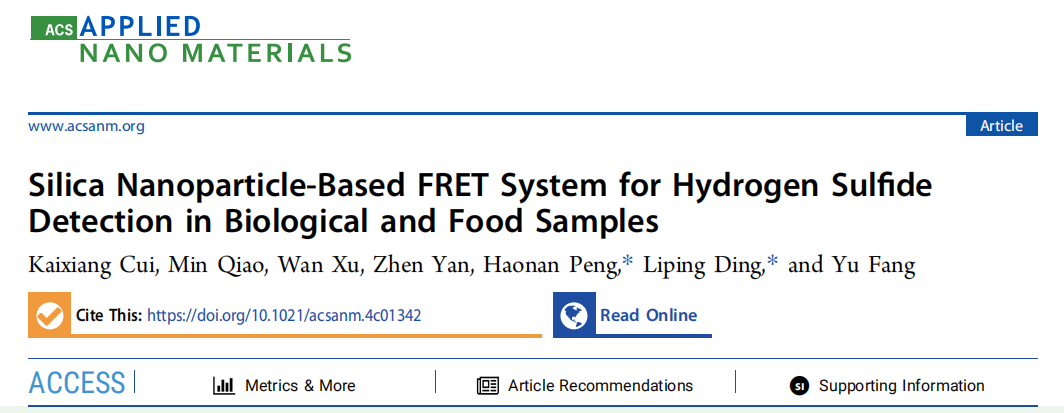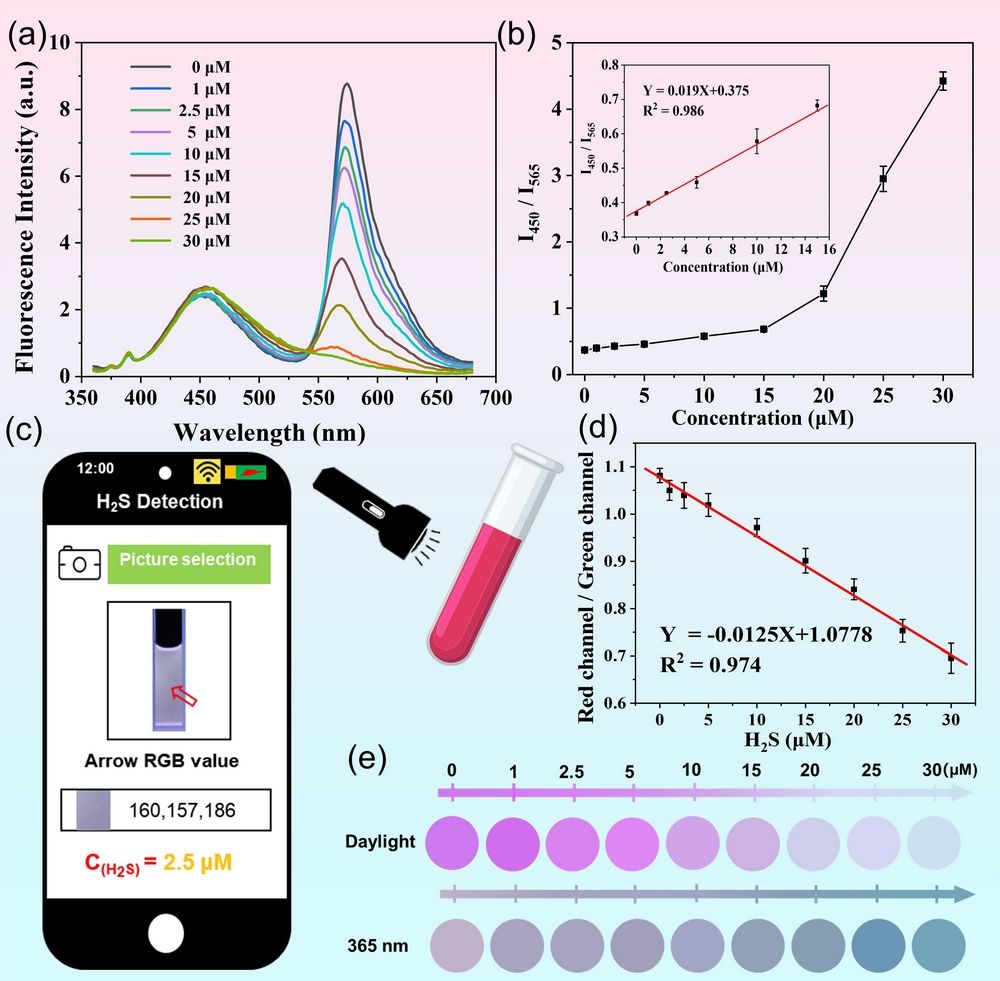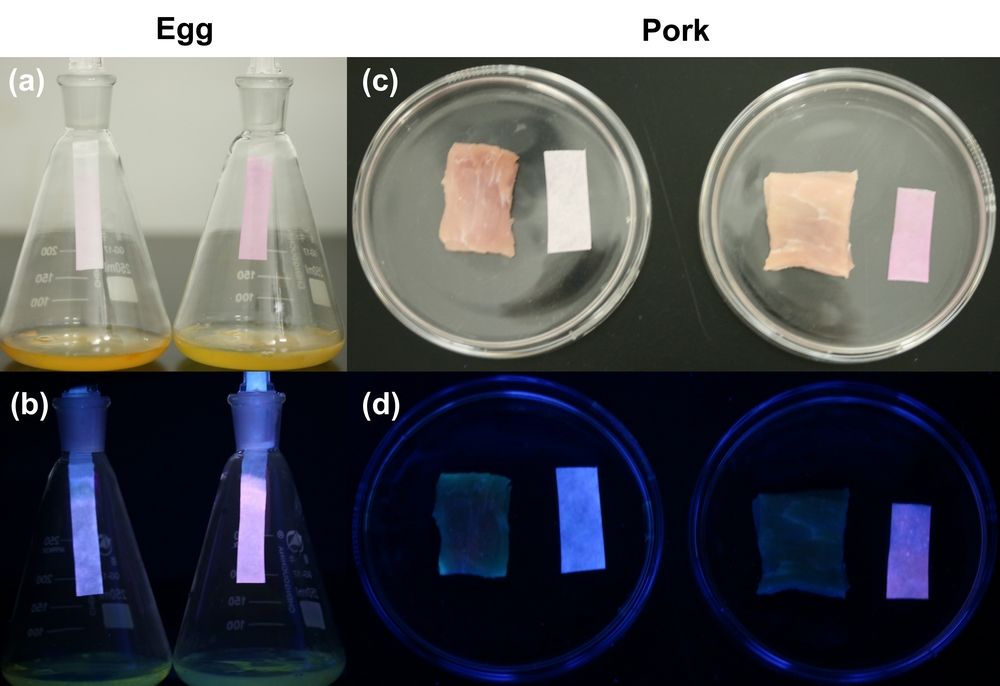
Kaixiang Cui, Min Qiao, Wan Xu, Zhen Yan, Haonan Peng*, Liping Ding*, and Yu Fang. ACS Appl. Nano Mater., 2024, 7, 11739-11748.

Hydrogen sulfide (H2S) is an important endogenous signaling molecule that plays a pivotal role in biomedical and food safety fields. Visualisation, portability and sensitive detection of H2S in biological and food samples are important for early diagnosis of certain diseases and ensuring food quality. In the field of H2S detection, the accuracy and validity of current methods face significant challenges, especially due to the low concentration of H2S in early stage diseases and food spoilage, the inherent complexity of the test samples, and the high number of interfering factors that pose a great obstacle to the accurate quantitative detection of H2S. The use of proportional fluorescent sensors for analyte detection can effectively overcome interferences and improve detection accuracy and practicality. By measuring the intensity ratio of fluorescence emission peaks at two different wavelengths, it has the advantages of high detection sensitivity, good visualisation and strong anti-interference ability. However, the preparation of proportional fluorescence sensors based on traditional organic small molecules usually requires a complex synthesis process, and poor biocompatibility and water solubility limit their use in some special scenarios.

Figure 1. Performance evaluation of Pyr@Py-SiO2 NPs in H2S detection in human urine: (a) Fluorescence spectra upon titration of H2S in human urine; (b) Plot of I450/I565 as a function of H2S concentration (Inset: the linear relationship between I450/I565 and H2S concentration ranging from 0 to 15 μM); (c) Schematic illustration of a smartphone-based H2S detection system; (d) The linear plot of read channel/green channel ratio of the sensor solution corresponding to different H2S concentrations; (e) Standard colorimetric card displaying color changes at various H2S concentrations, as monitored by a smartphone sensor platform. Error bars represent the standard deviation of three independent measurements.
Based on the above understanding, in this work, a H2S proportional fluorescent nanosensor (Pyr@Py-SiO2 NPS) based on the Förster resonance energy transfer (FRET) effect was designed and prepared by using a one-step co-condensation preparation method taking advantage of the ease of functionalization modification, good biocompatibility of SiO2 nanoparticles. The experimental results showed that the benzopyrylium unit in the Pyr@Py-SiO2 NPS could undergo a nucleophilic addition reaction with H2S, which interrupted the FRET process from pyrene to the pyronine unit in the nanosensor, leading to a significant decrease in the fluorescence emission of the pyronine unit at 565 nm. Therefore, the Pyr@Py-SiO2 NPS was characterized by a significant proportional type response to H2S with high selectivity, high sensitivity (LOD = 71.5 nM) and fast response (≤10 s). Based on the dual-wavelength emission of FRET effect, the response of Pyr@Py-SiO2 NPS to H2S was characterized by a significant colour change under both daylight and fluorescence, which is expected to enable portable and visual detection of H2S.

Figure 2. Application of Pyr@Py-SiO2 NPs test strips for H2S detection in food spoilage. (a, b) Egg spoilage ssessment: (top) daylight; (bottom) 365 nm UV light. Eggs without shells were placed in glass containers with test papers inserted (left, from egg with intact shell; right, from egg with broken shell). (c, d) Pork spoilage detection: left-stored at 25 °C for 4 days; right-stored at −4 °C for 4 days.
Pyr@Py-SiO2 NPs enables quantitative portable detection of H2S in 10% human urine based on a dual-mode response of colorimetric and proportional fluorescence detection with the assistance of a smartphone. A calibration curve and a standard colorimetric card were established for more convenient and intuitive detection of H2S in biological urine solutions. Pyr@Py-SiO2 NPs also showed great application potential for imaging endogenous H2S in onion endo-epidermal tissue cells. In addition, Pyr@Py-SiO2 NPs were loaded into test strip films for visual detection of the signal gas H2S during food spoilage. In conclusion, the newly designed and prepared fluorescent nanosensors, Pyr@Py-SiO2 NPs, provide an effective tool for H2S sensing in biological systems and food safety monitoring, with a large potential for practical applications.
First Author: Cui Kaixiang, doctoral Candidate, Shaanxi Normal University
Correspondence Authors: Prof. Ding Liping and Prof. Peng Haonan, Shaanxi Normal University
Full Text Link: https://pubs.acs.org/doi/10.1021/acsanm.4c01342